Cleaning and Adjusting the Scoring Motor of an Bally or Williams EM Pinball Machine
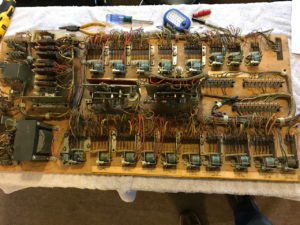
The score, or scoring motor is frequently the focus of problems in an EM pinball machine. On startup, it just keeps spinning. Or sometimes certain functions do not work. Most of the time, technicians attempt to identify and fix the contact that solves the problem. But a better way is to overhaul the entire score motor assembly.
Note: Click on an image for a larger photo.
Getting the Score Motor to Work Perfectly
In order for the score motor assembly to work perfectly day in and day out, it will be necessary to disassemble the switches from the motor, clean and adjust every one. This will proceed faster than expected, because it is much easier to do this than troubleshoot an issue with the motor.
This procedure covers Williams and Bally scoring motors. Gottlieb scoring motor overhaul will be covered later.
Materials Needed

-
-
-
- Switch Adjusting Tool.
- Screwdriver – multi type is fine. Slotted and (sometimes) Phillips.
- 91% Isopropyl Alcohol. Not rubbing alcohol. Higher than 91% is not needed.
- Q-tips.
- Small rubber bands – random sizes.
- A Sharpie or similar. Fine tip.
Optional, but recommended:
- Dremel or similar.
And one or more of the following:
- Dremel polishing wheel .
- 1/8″ Carbon Steel Brush 443 for Dremel. Highly recommended.
- Dremel Sanding Brush Wheel (flap wheel).
-
-
Understanding How the Switch Stacks Work
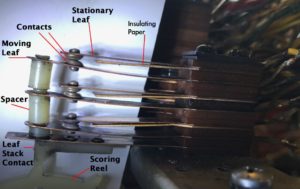
The leaf switch stack is made up of the following parts**:
*Copper leafs with a contact towards the end. Each set contains:
–Stationary Leaf on the contact that does not move.
One or two of these.
–Moving Leaf. One leaf that moves up and down.
This is the longest leaf.
*Several of these sets are usually placed on each other to create a Leaf Stack.
*Spacers that move Moving Leaf up and down.
*Fishpaper or Insulating that prevent electrical contact between leafs.
*At the bottom of the Leaf Stack is the Leaf Stack Contact.
*The Leaf Stack Rides on the Scoring Wheel.
Click on an image for a larger photo.
The leaf switches in the scoring reel move up and down as the reel moves. Some of the switches make contact when the leaf is down, others when the leaf is up, and many make different connections when the leaf is up and down.

**We admit that not every pinball person refers to these components exactly the same. So we did our best to make this understandable.
Williams and Bally have pretty good schematics explaining what each switch on each stack does. In this example, the score motor from a Williams Grand Prix is displayed (which is what is being worked on in these photos). The first switch is called ‘Impulse Forward’ and has just one switch. The label indicates what the switch does, which is impulse (activate) relays #1 & #2. This wheel has 10 notches, but the reel typically spins only half a revolution each time. This relay is typically involved in scoring 5x points (50 or 500). The switch closes as the Leaf Stack Contact gets pushed up.
Remove the Cabinet Bottom Panel
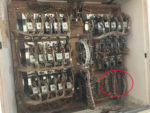
To make this easier, it will be necessary to remove the bottom panel from the game. This is made to be simple by the manufacturers.
Caution: Be certain to unplug the pinball machine before proceeding.
1) Set aside a clean clear table to hold the bottom panel.
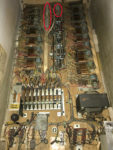
2) Unplug the ‘Jones’ plugs. There are usually a couple towards the back of the panel. And a few more in the wiring harness from the panel going up to the backbox. Pull up from the wafer. Do not grab the wires and pull.
3) Place plugs from the wiring harness coming from the bottom panel, down on top of the bottom panel.
4) There are two or more large screw heads holding the bottom panel to the cabinet. Loosen all of them so that the bottom panel is no longer held to the cabinet.
5) While checking to insure all wires are free and all screws are loose, carefully lift the bottom panel out of the cabinet and place onto your work area.
Overhaul the Williams or Bally Score Motor
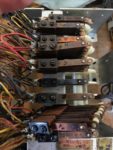
Once the bottom panel is placed in your work area, position yourself along side the scoring motor.
Label the switches so that they can be removed and then reassembled. Take photos for reference. Note that each stack of switches is held in position by two screws.

Check to see if the switches are accessible from both ends. If one end is partially blocked by something like the transformer, then all the switches will be removed, except for the one closest to the transformer.
However, if the switch stacks can be accessed from both ends, then all switch stacks will be removed, except for the center two.
Remove the stacks one at a time. When removing each stack, be careful to not let it come apart. Immediately wrap the switch stack with a rubber band – locating the rubber band between the two screws.
| Very important: When removing the switch stack, hold the area between the screws together with your fingers and then immediately wrap a rubber band around it. Failure to do so may result in the stack coming apart. Getting it back together is not easy. |
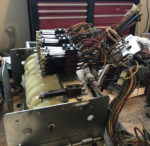
Note: The screws can fall out and be easily lost. Either leave them in place and try to have the rubber band hold them – or remove the screws and carefully store them aside.
Depending on your setup, you will either be working on the one remaining stack on one end, or the two left in the center.
Prior to proceeding, read the section on adjusting leaf switches. It is important how to adjust a leaf switch properly. Also note the section on cleaning the switch contacts. Note that these switches do not have a stationary blade.
Cleaning of the Switches
With the switch stacks out of the motor, it is relatively easy to access each switch and clean the contacts. Our favorite technique is to use the Dremel and the 1/8″ Carbon Steel Brush 443. Each switch contact should be nice and bright. Follow up with 91% alcohol and a q-tip to remove any leftover residue.
If following this procedure, the first stacks to work with are the two left over in the center. It is possible to remove one of those stacks to clean the contacts (wrap the stack with the rubber band!), then replace it for adjustment.
Adjusting the Switches
Click on a photo for a larger image.
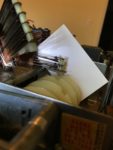
After the contacts are cleaned, note how the score motor moves and the switch stack moves. In this photo, the switch stack is ‘up’ most of the time, then moves ‘down’ into the notches. In this example, the switches open up at the top, them make contact when they are ‘down’.
Caution: Manually move the score motor in the correct direction. The stacks always climb up a gentle rise, then drop off a ‘cliff’. Moving in the wrong direction may destroy the switch and / or the motor.
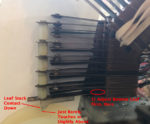
1) Using the switch adjusting tool and the proper technique, adjust the bottom leaf so that the leaf stack contact just barely touches the wheel or is slightly above the wheel at the low spot on the wheel. We do not want much pressure on the wheel, otherwise parts will wear faster.
 2) Next, adjust the bottom most moving leaf so that the spacer touches the bottom leaf. It should not push the bottom leaf down very much, but it must touch.
2) Next, adjust the bottom most moving leaf so that the spacer touches the bottom leaf. It should not push the bottom leaf down very much, but it must touch.
The force of this leaf down will push the leaf stack contact down just a little.
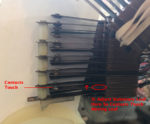
3) Finally, adjust the shorter stationary leaf up so that the two contacts meet and make firm electrical contact. This leaf must make contact with the longer moving leaf. But when the stack moves up, these two contacts must separate.

4) Check your adjustments by rotating the wheel in the correct direction. The leaf stack contact will ride along the wheel and push the stack up. Ignore the switches that have not been adjusted and just look at the one you worked on. When the leaf moves up, the two contacts must separate. If they do not, then adjust the shorter stationary leaf back down a little bit so that the two contacts separate.
Repeat steps 2 – 4 for each of the remaining leafs.
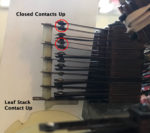
Note that some contacts will occur when the stack is up. When adjusting a lower set of leafs, while performing steps 2 – 4, insure that the upper shorter fixed leaf does not make contact when down, but does make contact while up.
Adjusting the remaining switches on the stack can sometimes affect the lower adjustments. After completing all the adjustments, go back and review the stack for proper operation. One may find that an earlier adjustment might need changing.
Also pay attention to the pressure of the Leaf Stack Contact onto the wheel. If the downward pressure of all the leafs is too great, then the parts will wear. It might be necessary to go back and lift up each of the longer leafs just a little.
First time through, this process may seem daunting. Try starting with the smallest switch (least number of leafs) first. Repeat adjusting your first stack. After a couple of time, this will become much easier.
Reassembly
After finishing up with one stack, carefully check its operation to insure that it is working properly.
Then attach the next stack in the order. Repeat the above adjustment process. Continue with each stack until all are cleaned and adjusted.
While the bottom panel is out, we recommend cleaning and adjusting the other relays. Then just reassemble. Enjoy that your score motor will work like the pinball machine is brand new and it likely will not give your problems for years to come.
Comments
Comments, including suggestions, improvements, errors, etc. are welcome (see below). We occasionally make a mistake. Please help and let us know.
If you have a specific question about your game that does not directly apply to this page, please see our FAQ section.
External Links
EM Repair the Score Motor – Detailed information from the always excellent PinWiki





